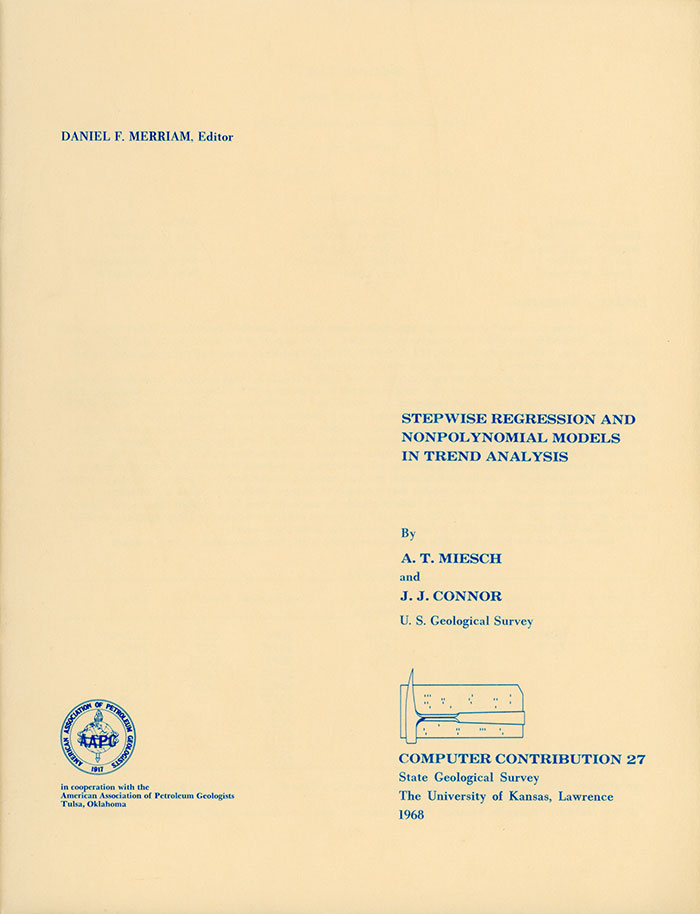
Kansas Geological Survey, Computer Contributions 27, originally published in 1968
U.S. Geological Survey

Originally published in 1968 as Kansas Geological Survey Computer Contributions 27.
Techniques of fitting regression surfaces to geologic map data have been applied widely during the last decade, since the work of Krumbein (1956) and Miller (1956). The procedures, as used in geology, generally are referred to as trend analysis. Trend analysis of map data is performed primarily to separate and describe various components of variation that might be present, thereby facilitating geologic interpretation. Another purpose of trend analysis is to derive a regression equation that can be used for interpolation or prediction between control points on the map. Although there have been numerous applications of trend analysis to geologic problems since 1956, the general procedure has remained essentially the same as described by Krumbein (1959), except for some recent applications of Fourier series as an alternative to the polynomial models generally used (Preston and Harbaugh, 1965; James, 1966; Krumbein, 1966). This paper describes a somewhat modified approach to the general procedures of trend analysis in which a stepwise regression method is used. Stepwise regression has been used in trend analysis previously by Agterberg (1964), and a brief description of the technique used here was given previously by Miesch and Connor (1967).
Trend analysis directed toward interpolating or predicting values between map control points can, in many cases, be relatively straightforward. At least the criteria for judging the suitability of the regression surface can be clearly stated. The surface should account for a high proportion of the total sum of squares in the dependent variable, the deviations of the observed values of the dependent variable should not be autocorrelated, and the surface should "behave well" between the map control points. That is, there should be no more maxima or minima in the surface than are called for by the data being analyzed. The best polynomial equation that can be used for prediction is the lowest order polynomial leading to nonsignificant autocorrelation in the trend deviations.
Selection of the best trend surface equation for separating and describing components of variation in the map data is considerably more difficult, and criteria that can be used to select the best equation consist mostly of geologic factors pertinent to the particular problem. This may require that a number of surfaces (models) be fitted and examined. The general mathematical forms of the equations must be chosen on substantive grounds, but following this they can be refined using either geologic criteria (if this is possible) or various statistical tests. Most trend analysis work so far has involved refinement of polynomial equations up to about fifth degree by dropping polynomial terms in groups (for example, dropping fifth degree terms, then fourth degree, and so forth). By using stepwise regression methods, the terms to be used in the equation can be selected individually according to their potential effectiveness in reducing the total sum of squares in the dependent variable - and dropped from the equation individually if they are not effective or if they are redundant. The terms under examination need not be restricted to polynomials, however; other terms may be better in particular problems. Terms selected frequently depend on the X-Y coordinate system used and by changing the coordinate system, by entering different kinds of terms into the stepwise procedure, and by changing the significance level at which terms are to be entered into or deleted from the regression equation, a number of different trend surfaces of about equally good fit to the observed data can be derived. The relative geologic significance of these surfaces remains a matter of subjective judgment.
Stepwise regression generally leads to trend-surface equations which are considerably more efficient than conventional polynomial equations in that they may account for large proportions of the total sum of squares with many fewer terms. An attractive consequence of this is that the matrix operations performed to derive the coefficients are less affected by roundoff errors. Moreover, the derived coefficients are more stable—or less sensitive to small errors in the data.
Read the PDF version (9.9 MB)
Kansas Geological Survey
Placed on web Sept. 6, 2019; originally published 1968.
Comments to webadmin@kgs.ku.edu
The URL for this page is http://www.kgs.ku.edu/Publications/Bulletins/CC/27/index.html